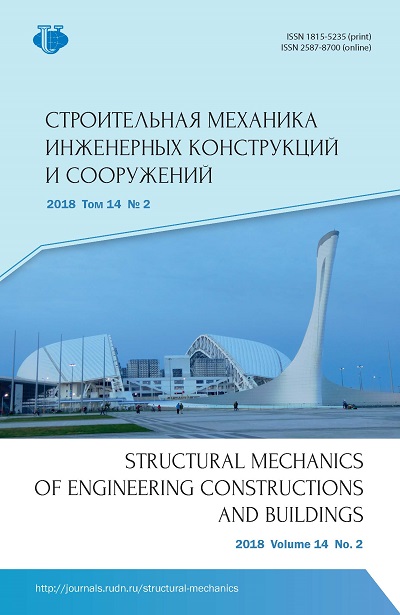Finding the extreme values of operating characteristics for quality control of construction products
- Authors: Chiganova N.M1
-
Affiliations:
- Moscow State University of Civil Engineering (National Research University)
- Issue: Vol 14, No 2 (2018)
- Pages: 84-91
- Section: Analysis and design of building structures
- URL: https://journals.rudn.ru/structural-mechanics/article/view/18643
- DOI: https://doi.org/10.22363/1815-5235-2018-14-2-84-91
Cite item
Full Text
Abstract
The matter of control planning by variables is essentially the inverse problem of interval estimation. Therefore, when determining control plans (“n” is the sample size, “k” is the eligibility criterion), the results of interval estimation are used. The algorithm of interval estimation, proposed by L.N. Bolshev and E.A. Loginov, presupposes finding the upper and lower bounds of the operational characteristic of quality control, which in turn represents the probability of acceptance of the batch with a quality level not exceeding the consumer risk. In this case, the probability of batch rejection is not more than the manufacturer risk. In this article, an attempt is made to find the extreme values of the operating characteristic in an explicit form. As a result, operative characteristics formulas were obtained in an explicit form, which made it possible to significantly simplify the determination of control plans with bilateral tolerance for the controlled parameter that characterizes a specific product. In construction industry, any sign on which the reliability of the construction product is characterized is implied as a controlled parameter.
About the authors
Nadezhda M Chiganova
Moscow State University of Civil Engineering (National Research University)
Author for correspondence.
Email: chiganovanm.mgsu@gmail.com
Candidate of Physical and Mathematical Sciences, Associate Professor, Department of Applied Mathematics, National Research Moscow State University of Civil Engineering (NRU MGSU). Research interests: quality assessment and the reliability of products, test planning, interval estimation of parameters of reliability of building products
26 Yaroslavskoye Shosse, Moscow, 129337, Russian FederationReferences
- Kramer G. (1975). Matematicheskie metody statistiki [Mathematical methods of statistics]. Moscow: Mir Publ. 648. (In Russ.)
- Kartashov G.D., Chiganova N.M. (1980). K obosnovaniyu planov kontrolya po kolichestvennomu priznaku pri dvuhstoronnem dopuske [A justification of sampling plans by variables in bilateral tolerance, Statistical Methods collection] // Statisticheskie metody, Perm': Izdatel'stvo Permskogo gosudarstvennogo universiteta, 66–81. (In Russ.)
- Chiganova N.M. (2015). Logarifmicheskaya vypuklost' po parametru nekotoryh raspredeleniya [Logarithmic convexity in the parameter of certain distributions, Natural and technical sciences]. Estestvennye i tehnicheskie nauki, Vol. 6, 14–17. (In Russ.)
- Medvedev V., Pustovgar A. (2015). Influence of Chemical Additives on Radiation Stability of Concrete – Theoretical Basis and Evaluation Method, Applied Mechanics and Materials, Vol. 725–726, 377–382.
- Chiganova N. (2016). Reliability theory application for building structures reliability determination, MATEC Web of Conferences, Vol. 86. URL: https://doi.org/10.1051/matecconf/ 20168602009 (Accessed 12.09.2017).
- Kir'yanova L.V., Usmanov A.R. (2012). Assessment of spectral density of the aerodynamic factor of front resistance. Vestnik MGSU, No 10, 88–94. (In Russ.)
- Bolshev L.N., Loginov E.A. (1966). Interval estimates in the presence of interfering parameters. Theory of Probability and its applications, 11 (1), 94–107. (In Russ.)
- Gnedenko B.G., Belyaev Yu.K., Slov’ev A.D. (2010). Mathematical methods in the reliability theory. Moscow: Nauka Publ., Vol. 2, 582. (In Russ.)
- Kobzar A.I. (2006). Applied mathematical statistics (For engineers and scientists). Moscow: Fizmatgiz, Vol. 1, 816. (In Russ.)
- Tarasov D.V., Tarasov R.V., Makarova L.V., Ermishina Ya.A. (2015). Improvement of quality control of construction products. Modern problems of science and education, No 1–1. URL: https://www.science-education.ru/ru/article/view?id=17591 (Accessed 12.09.2017). (In Russ.)
















